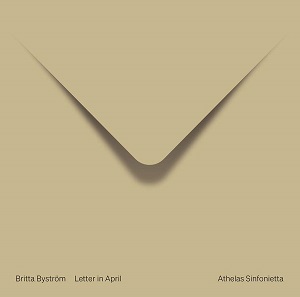
Britta Byström (b. 1977)
Letter in April (2011)
Baum in der Stadt (2014)
Images From the Floating World (2019)
Figures at the Seaside for cello and chamber ensemble (2020)
Anne Ngoc Søe (violin)
Maria Isabel Edlung (cello)
Athelas Sinfonietta/Eirik Haukaas Ødegaard
rec. 2021/22, KoncertKirken, Copenhagen
Dacapo 8.226724 [59]
In 2010, the Katrina Culture Association commissioned from Britta Byström a piece for Resounding Letters, a concert series in Stockholm. (I owe this fact, and other facts and quotations in this review, to Andrew Mellor’s generously documented booklet notes.) The title of the series made the composer think of the Danish poet Inger Christensen, and especially of her collection Letter in April, strongly influenced by the music of Olivier Messiaen. This may explain the instrumental line-up, modelled after Quatuor pour la fin du temps: clarinet, violin, cello and piano.
The comparison with Messiaen’s work ends here, because Byström’s music sounds quite different. She describes her piece as a series of events that suggest the coming of Spring. From the very opening of the piece, the music opposes a generally agile piano part skipping lightly over the other instruments. Some transformation does occur progressively beneath the surface “charting a journey from turbulence to calm by almost imperceptible degrees”. In this beautifully conceived piece, Britta Byström proves herself to be a fine composer of subtly wrought chamber music. By the way, the whole programme mostly features chamber music.
Many of Byström’s pieces derive inspiration or basic idea from extra-musical subtexts, such as visual impressions or literary sources. Baum in der Stadt for solo violin was influenced by names which Swiss-German artist Paul Klee gave to his paintings, but the music does not aim for any direct illustration. On the contrary, the most striking feature – which may seem improvisatory – is its taut construction. It is strengthened by the recurring use of some building blocks, particularly a motif heard right at the start and then often subtly varied in all this compact work. Anne Ngoc Søe plays outstandingly this technically demanding pice, ultimately rewarding to listen to.
Images From the Floating World is also programmatic, inspired by a saga. Andrew Mellor writes: “Perhaps the greatest of the Icelandic sagas is that known as Njal’s Saga […]”, and proceeds to summarise the story. Byström’s “take” is this beautiful string quartet, laid out as a suite of six concise movements. Their tempo indications – Con moto, Ritmico, Leggiero, Grazioso, Energico, Con moto – point to how the music sounds. The writing is varied and imaginative without ever resorting to gimmicks. It even pays brief oblique homage to older composers such as Carl Nielsen. It can be fairly exacting and demanding, but it can also be disarmingly and deceptively simple, and deeply expressive. Take the last movement: a simple tune emerges from a pizzicato figuration and is “layered up in canon”, and that leads the quartet to its conclusion. I enjoyed this work enormously. I hope that many ensembles will avidly pick it up; it deserves to be heard.
The programme concludes with Byström’s cello concerto Figures at the Seaside. It is scored for “a small, versatile ensemble of single woodwinds, brass, strings, harp, percussion, and a prominent piano doubling vibraphone”. The booklet says: “The title is taken from a surrealist painting by Pablo Picasso depicting big, rotund bodies entwined on a yellow-sand beach.” It may not be easy to relate to the music and its sources right away. Byström worked closely with cellist Maria Isabel Edlung, “taking as her starting point the cellist’s playing style and her relationship with the music of Johann Sebastian Bach. The work makes use of the Prelude No. 12 in F minor from the composer’s Well Tempered Clavier, Book II”.
Byström’s writes imaginatively for the soloist and for the small orchestral forces. She makes the best of some of the limitations she imposed on herself; the results are impressive. No matter what considerations have triggered it, there emerges pure music, with no picturesque programme. The piece was composed for Edlund for her graduation at the Royal Academy of Music in Aarhus. Needless to say, she plays beautifully and with musicality throughout.
In short, this is a superb release on all counts. Performances seem faultless to me. I wish to acknowledge again Andrew Mellor’s informative notes; I have quoted from them generously. This is a fine, welcome addition to Britta Byström’s discography, and a must for those who know and appreciate the music of this endearing composer.
Hubert Culot
Help us financially by purchasing from





















